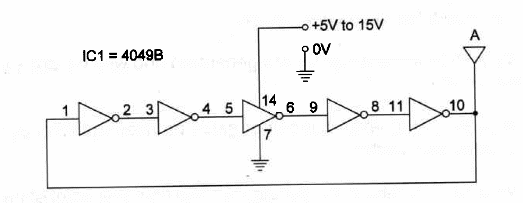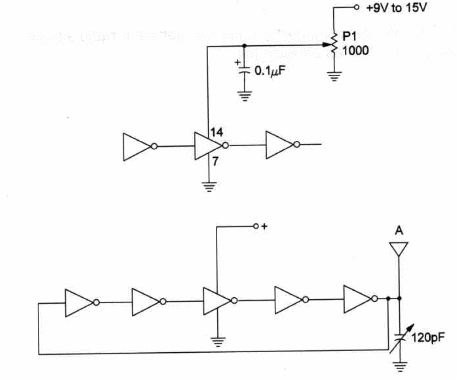Here is a project that should be constructed by those with no patience for electronics building. Only one component is used to build a complete wireless transmitter!.
Of course; this is the simpleàt way to generate radio signals. It is a CW (continuous wave) transmitter and is powerful enough to plunk down a signal anywhere on the 550 kHz to 7 MHz band.
The fundamental frequency depends upon power supply voltage and is in the
range between 100 kHz and 1 MHz, but there are strong harmonics reaching up to 7 MHz.
Figure 1 shows the schematic diagram of this simple transmitter.

As you can see, we have only one component a 4049 CMOS IC that is formed by six inverters. In this project only ñve inverters are used.
The circuit is bowered from AA cells or battery, and current drain is very Iow.
As an experimental project you can place the IC on a universal solderless board.
The antenna is a single wire 2 to 5 feet Iong.
A common AM (medium wave or short wave) receiver is placed near the transmitter.
A signal can be tuned in from distances up to some feet away.
There are two ways to tune the transmittçL shown in Figure 2.

ln the first case, as the frequency is voltage-dependent, we change the power supply voltage.
Use a 12 volt power supply and adjust the voltage in the IC with P1. In the second case, we include a variable capacitor in the feedback Ioop to alter the frequency.
One-Component Transmitter
IC - 4069 or 4049 CMOS integrated circuit (only this!)
(And a power supply, of course)
Ideas to Explore
To Iearn more about the circuit and device:
Explain how radio signals are generated and Why we don't need a tuned circuit.
Why should an even numberlof gates be used in this circuit? Why an odd number work?
Why can you tune in the signals on morethan one point of the dial?
Science projects:
Send telegraph signals ttuough awall using this circuit as transmitter and an AM radio as reoeiver.
Explain how computer circuits can generate radio signals (noise), using this circuit as an example.
Note: This circuit is part of the author’s book Fun Projects for the Experimenter Vol1 – TAB Books – 1998 (link para download)



